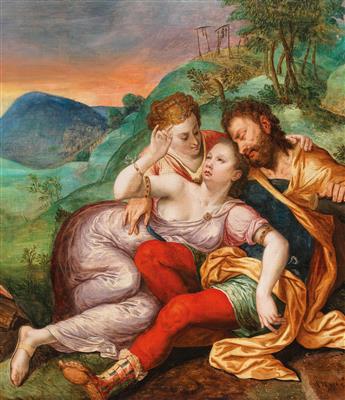Master of the Prodigal Son

(active in Antwerp and Italy 1530–1560)
Lot and his Daughters,
inscribed lower right: DESIDIA,
oil on panel, 78 x 68 cm, framed
Provenance:
Comte et Comtesse Anne Philippe Picot de Moras, Château de Gussignies, L’Avesnois;
Baron René de Witte, Château de Gussignies, L’Avesnois, from 1912 until 1970;
Mme Marx collection;
Private collection, Luxembourg
We are grateful to Jan de Maere for confirming the attribution to the Master of the Prodigal Son after examination of the original.
The sensuous and mannered composition of the present work is typical of the master. The proportions of the figures display influences from the School of Fontainebleau, though with a Flemish sensitivity for the natural setting, such as in the apocalyptic fires of Sodom illuminating the horizon and the rendering of the serpentine tree-trunks in the background. The present work, although sitting alongside other treatments of the subject by the master, is remarkable for its originality of its scheme, although de Maere notes that the facial types are redolent of the work for which the master is so named, The Parable of the Prodigal Son, conserved in the Kunsthistorisches Museum, Vienna (inv. no. GG 986). Infra-red reflectography has revealed underdrawing and pentimenti in the composition, which further illustrate the innovative approach of the master to the present work. The artist and his workshop used the present figure grouping in other compositions such as the painting entitled Allegory of Virtue in the Beneditktinerabtei Ottobeuren, Bavaria.
The so-called Master of the Prodigal Son, sometimes also named Monogrammist LK (Leonard Kroes), Pseudo-Lombard or Master of Tobias, was an early Netherlandish painter who was primarily active in Antwerp, most likely from the 1530s until at least the 1550s. The work of the Master of the Prodigal Son shows the influence of leading painters working in Antwerp in the sixteenth century, such as the mannerist masters Pieter Coecke van Aelst, Jan Mandijn and Frans Floris. This aspect is most obvious in his compositions with large figures, like the present painting, where the figure of the semi-clad daughter in the foreground, and drapery encircling the inebriated Lot, exhibit a sculptural character. However, the sharply accented realism of some details, such as the finely studied musculature of Lot’s exposed neck, shows also the influence of Pieter Aertsen, who carefully studied the textures of the world around him ad vivum.
Specialist: Damian Brenninkmeyer
 Damian Brenninkmeyer
Damian Brenninkmeyer
+43 1 515 60 403
damian.brenninkmeyer@dorotheum.at
08.06.2021 - 16:00
- Estimate:
-
EUR 25,000.- to EUR 35,000.-
Master of the Prodigal Son
(active in Antwerp and Italy 1530–1560)
Lot and his Daughters,
inscribed lower right: DESIDIA,
oil on panel, 78 x 68 cm, framed
Provenance:
Comte et Comtesse Anne Philippe Picot de Moras, Château de Gussignies, L’Avesnois;
Baron René de Witte, Château de Gussignies, L’Avesnois, from 1912 until 1970;
Mme Marx collection;
Private collection, Luxembourg
We are grateful to Jan de Maere for confirming the attribution to the Master of the Prodigal Son after examination of the original.
The sensuous and mannered composition of the present work is typical of the master. The proportions of the figures display influences from the School of Fontainebleau, though with a Flemish sensitivity for the natural setting, such as in the apocalyptic fires of Sodom illuminating the horizon and the rendering of the serpentine tree-trunks in the background. The present work, although sitting alongside other treatments of the subject by the master, is remarkable for its originality of its scheme, although de Maere notes that the facial types are redolent of the work for which the master is so named, The Parable of the Prodigal Son, conserved in the Kunsthistorisches Museum, Vienna (inv. no. GG 986). Infra-red reflectography has revealed underdrawing and pentimenti in the composition, which further illustrate the innovative approach of the master to the present work. The artist and his workshop used the present figure grouping in other compositions such as the painting entitled Allegory of Virtue in the Beneditktinerabtei Ottobeuren, Bavaria.
The so-called Master of the Prodigal Son, sometimes also named Monogrammist LK (Leonard Kroes), Pseudo-Lombard or Master of Tobias, was an early Netherlandish painter who was primarily active in Antwerp, most likely from the 1530s until at least the 1550s. The work of the Master of the Prodigal Son shows the influence of leading painters working in Antwerp in the sixteenth century, such as the mannerist masters Pieter Coecke van Aelst, Jan Mandijn and Frans Floris. This aspect is most obvious in his compositions with large figures, like the present painting, where the figure of the semi-clad daughter in the foreground, and drapery encircling the inebriated Lot, exhibit a sculptural character. However, the sharply accented realism of some details, such as the finely studied musculature of Lot’s exposed neck, shows also the influence of Pieter Aertsen, who carefully studied the textures of the world around him ad vivum.
Specialist: Damian Brenninkmeyer
 Damian Brenninkmeyer
Damian Brenninkmeyer
+43 1 515 60 403
damian.brenninkmeyer@dorotheum.at
|
Buyers hotline
Mon.-Fri.: 10.00am - 5.00pm
old.masters@dorotheum.at +43 1 515 60 403 |
| Auction: | Old Master Paintings I |
| Auction type: | Saleroom auction with Live Bidding |
| Date: | 08.06.2021 - 16:00 |
| Location: | Vienna | Palais Dorotheum |
| Exhibition: | 29.05. - 08.06.2021 |
